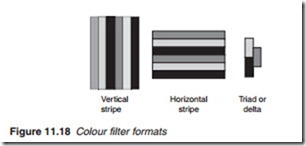Greyscale and colour generation
In general, there are two ways of generating greyscale: digital and ana- logue. The digital method includes the sub-field coding known as ‘time ratio’ technique employed in plasma panels. The other digital technique is the ‘area ratio’ in which the pixel cell is divided into several smaller areas, e.g. 6, 8 or 10. Each area is energised independently. The sum total of the luminance of the separate areas is the luminance of the pixel cell. The analogue method is by far the simplest technique by which luminance is determined by the instantaneous value of the voltage fed into the data bus and this is the method used in LCD panels.
With the video data being in digital format, the analogue technique requires a digital-to-analogue DAC. Traditionally, a resistor-DAC was used employing a resistor ladder to generate a set of binary-weighted reference voltages, which may be combined to produce an instantaneous voltage that represents the value of the signal. Given eight different reference voltages, 28 = 256 different greyscale voltage values may be produced. In the case of LCD panel drives, two separate sets of reference voltages are needed because of the asymmetrical gamma characteristics encountered during polarity inversion. The resistor chains may of course be incorporated within the DAC chip itself which can also provide the necessary gamma correction. Current LCD panels use linear DACs and sample-and-hold architecture in which the DACs are shared by the column video data thus reducing their number and with it the chip size.
To produce colour, each pixel is divided into three R, G and B sub-pixels or cells in the same way as a plasma pixel. While this arrangement can produce a greyscale, it cannot generate a colour image. To do that, three filters, one for each of the three primary colours are provided on a masked filter substrate. The RGB elements of this colour filter line up one-to- one with the pixel cells on the TFT-array substrate. Because the cells are too small to distinguish independently, the RGB elements appear to the human eye as a mixture of the three colours. Practically, any colour can thus be produced by mixing these three primary colours. Pixel cells may be arranged in three formats: vertical stripe, horizontal stripe and the triad or delta as illustrated in Figure 11.18. The most popular with manufactur- ers is the vertical stripe which is sometimes described as 3 m X n format. Thus, for an SVGA-resolution LCD panel (resolution 800 X 600), the total number of pixel cells = 800 X 3 X 600 = 1,440,000 with the number of columns = 800 X 3 = 2400.
The number of colours provided by the LC display is determined in the same way as that for plasma panels namely by the number of combinations
of R, G and B that may be produced given a particular greyscale levels. In general, the number of colours = 2n where n is the total number of bits allo- cated to the video which for a 24-bit video is 24 bits. Given this, the num- ber of different colours = 224 = 16.78 million. Alternatively, the same figure may be produced by multiplying the greyscales levels of each colour, namely 256 X 256 X 256 = 16.78 million.
